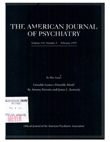Bipolar II: the most common bipolar phenotype?
Abstract
OBJECTIVE: The purpose of this study was to compare the pattern of affective psychopathology in families ascertained for genetic linkage studies through bipolar I probands to that in families ascertained through bipolar II probands. METHOD: All available first-degree relatives (N = 266) of 48 bipolar I and eight bipolar II probands were interviewed with the Schedule for Affective Disorders and Schizophrenia- -Lifetime Version by one of two psychiatrists who had attained high interrater reliability for bipolar II disorder and other diagnoses. RESULTS: Bipolar II disorder was the most common affective disorder in both family sets. Forty percent of the 47 first-degree relatives of the bipolar II probands and 22% of the 219 first-degree relatives of the bipolar I probands were diagnosed with bipolar II disorder. On the other hand, only one bipolar I relative was found in the bipolar II families. CONCLUSIONS: Bipolar II disorder was the most prevalent affected phenotype in both bipolar I and bipolar II families and was the only expressed phenotype in half of the bipolar II families. This suggests that bipolar II disorder is genetically related to but less complex than bipolar I disorder. Accurate diagnosis of bipolar II disorder may be crucial in finding the genetic loci underlying bipolar disorders generally.
Access content
To read the fulltext, please use one of the options below to sign in or purchase access.- Personal login
- Institutional Login
- Sign in via OpenAthens
- Register for access
-
Please login/register if you wish to pair your device and check access availability.
Not a subscriber?
PsychiatryOnline subscription options offer access to the DSM-5 library, books, journals, CME, and patient resources. This all-in-one virtual library provides psychiatrists and mental health professionals with key resources for diagnosis, treatment, research, and professional development.
Need more help? PsychiatryOnline Customer Service may be reached by emailing [email protected] or by calling 800-368-5777 (in the U.S.) or 703-907-7322 (outside the U.S.).



